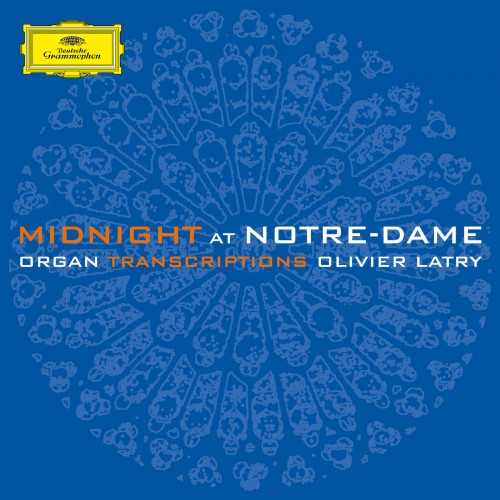
Performer: Oliver Latry
Format: FLAC (tracks)
Label: Deutsche Grammophon
Release: 2019
Size: 1.15 GB
Recovery: +3%
Scan: cover
Johann Sebastian Bach:
01. Cantate No.29 “Wir danken dir, Gott, wir danken dir”, BWV 29-1. Sinfonia (Transcr. Dupré for Organ)
02. Herz und Mund und Tat und Leben, Cantata BWV 147-1. Réjouis-toi mon ame (Transcr. for Organ by M. Duruflé)
Wolfgang Amadeus Mozart:
03. Adagio and Fugue in C Minor, K.546-1. Adagio (Transcr. Guillou for Organ)
04. Adagio and Fugue in C Minor, K.546-2. Fugue (Transcr. Guillou for Organ)
Richard Wagner:
05. Tannhäuser-Pilgrim’s Chorus (Transcr. for Organ by F. Liszt)
Hector Berlioz:
06. La Damnation de Faust, Op.24-Marche hongroise (Transcr. for Organ by H. Büsser)
Sergey Rachmaninov:
07. Prélude in C-Sharp Minor, Op. 3 No. 2 (Transcr. Vierne for Organ)
Sergei Prokofiev:
08. Toccata, Op.11 (Transcr. for Organ by J. Guillou)
Johann Sebastian Bach:
09. Cantata No.22 “Jesus nahm zu sich die Zwölfe”, BWV 22-1. Mortifie-nous par ton bonté (Transcr. for Organ by M. Duruflé)
10. Partita for Violin Solo No.2 in D minor, BWV 1004-5. Chaconne (Transcr. for Organ by H. Messerer)
While Paris slept, Notre-Dame’s organist Olivier Latry recorded this musical celebration of well-known classics. An extraordinary sonic experience for the first time on HighResAudio.
The famous organ of Notre-Dame de Paris is a brilliantly colourful instrument which in the course of numerous overhauls has acquired a versatility allowing it to encompass every style. It was completely rebuilt between 1863 and 1868 by the visionary organ builder Aristide Cavaillé-Coll, who installed five manuals and 86 stops, and in 1932 a rich palette of neo-classical colours was added. Between 1963 and 1971 Pierre Cochereau further extended the instrument’s possibilities and replaced the old mechanical action with a faster electro-pneumatic action. Finally, in 1992, computer technology increased yet further the organ’s resources by making its 110 stops completely independent.
None of these changes, however, affected the instrument’s soul, which is still essentially that of a Romantic, symphonic organ reflecting an aesthetic in which the spirit precedes the letter. And the spirit blows where it wishes, especially the spirit of creativity. Although the present programme is given over exclusively to transcriptions, these are not mere adaptations intended for virtuosos. Rather they are arrangements of vocal, orchestral or piano pieces by true creative artists who, while also being performers, are composers in their own right – composers whose experience has been illuminated by their contact with these works on which they have lavished their creative imagination.
Every organ transcription requires the arranger to rethink the original score. Even though listeners may have the impression that the organ can play anything, each of its manuals has a compass of only four and a half octaves (the piano by contrast has more than seven octaves at its disposal). As a result the pedal-board has to be used for the lower register and, more generally, the possibilities of registration have to be explored, in other words, the mixture of different stops distributed over the various manuals. Although no two organs are alike, the transcriptions that are heard here are in principle conceived for an instrument with three manuals and pedal-board, the few indications concerning nuance and registration remaining essentially no more than suggestions. It is left to the organist and the means at his disposal to rediscover what the arranger wanted to achieve and, above all, to establish this through the details of the transcription. One could say that all that remains of the original composition are the idea and form. The arranger has fixed these in black and white within a new perspective, and it is now up to the interpreter to breathe new life into them by means of colour and movement.
“Sizzling sounds abound, too, in Berlioz’s ebullient Hungarian March, though Latry applies a tad too much rubato at times (a complaint levelled at organists the world over) and the requisite rhythmic spring suffers. The two remaining tracks are of Duruflé’s nondescript transcriptions of Bach’s Jesu Joy of Man’s Desiring and Mortify Us. The former is taken too slowly and Latry makes a slightly labourious job of the latter.
These criticisms apart, the engineers have done a magnificent job in capturing the soul of this Romantic, symphonic organ. Latry’s mastery of both instrument and repertoire is undeniable. I recommend it to even those who have an aversion to organ discs or transcriptions.” (Gramophone)
“And if that’s not enough, try Latry’s phenomenal rendition of Jean Guillou’s transcription of Prokofiev’s Toccata Op. 11: how does a human play such a thing on the organ? It’s just not possible! And for good measure, Latry dispatches Berlioz’s Hungarian march from La Damnation de Faust with dazzling style–and effortless technique. And the sound–from brilliant, refulgent upper reeds, trumpets, and winds to the great, resounding lower registers–is ideal, placing us in the very middle of that incomparably huge, timeless Gothic-cathedral space. And you don’t even have to turn this one up to get room-filling effect. Organ fans will already have this–and if you’re not one already, try it and believe. Outstanding!” (David Vernier, ClassicsToday)